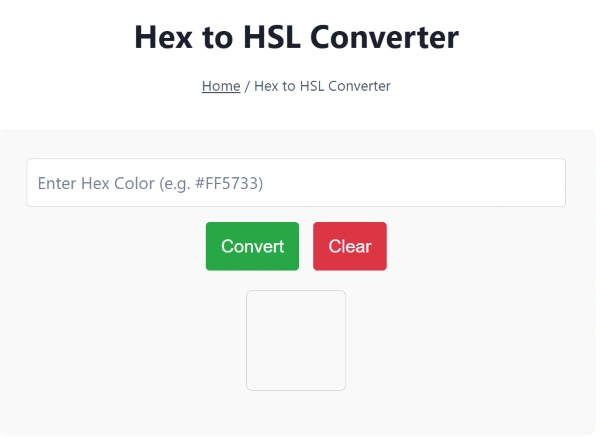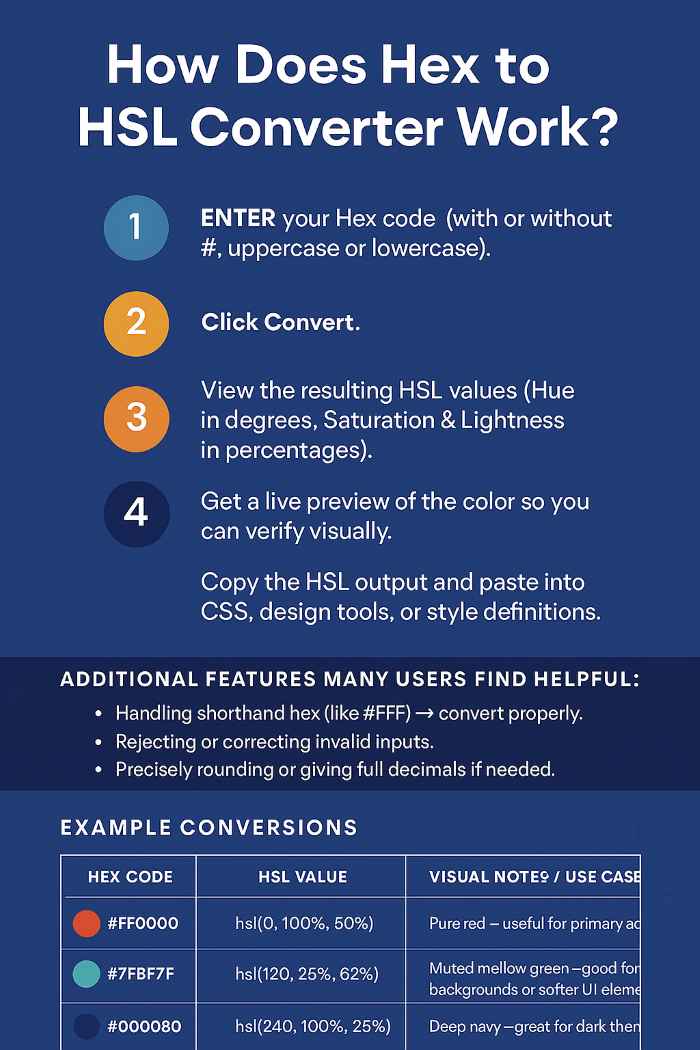Hex to HSL Converter
Reverse Conversion Tool: HSL to Hex (more hex color code conversion tools are shared below)
Hex to HSL Converter – Convert Hexadecimal Color Codes to HSL Format
Instantly convert any Hexadecimal (Hex) color code into its HSL (Hue, Saturation, Lightness) equivalent. Whether you’re coding, designing a UI, working on digital art, or fine-tuning a color theme, this tool gives you clarity and control over your color palette.
The Hex to HSL Converter image is shown below:

What Is a Hex Color Code?
A Hex code is a way to represent colors using hexadecimal notation. It’s usually in the form:
#RRGGBBRR,GG,BBare two-digit hex values (00-FF) representing red, green, blue (0-255).- Works without the “#” in many tools.
- Commonly used in CSS, HTML, mobile and web development because browsers support it directly.
What Is the HSL Color Model?
HSL stands for:
- Hue (H): the color type or tone, measured in degrees (0-360°) on a color wheel (e.g. 0° = red, 120° = green, 240° = blue).
- Saturation (S): how rich or faded the color is (0% = gray, 100% = fully vivid).
- Lightness (L): how light or dark the color is (0% = black, 100% = white; 50% = “true” shade of the hue).
HSL is more intuitive for designers because you can adjust how bright or muted a color looks while keeping its underlying hue.
Why Convert Hex → HSL?
| Scenario | Why It Matters |
|---|---|
| Theming & UI Design | Adjusting Lightness in HSL lets you produce hover / active / disabled states more easily from the same base hue. |
| Creating Consistent Palettes | Using HSL, you can keep hue constant and vary saturation/lightness to derive harmonious shades. |
| Accessibility | Lightness adjustments help ensure good contrast for text/background combinations. |
| Design Tools / Style Guides | Some tools use HSL natively, so converting helps align code base with design toolkit standards. |
| Learning Color Models | Seeing the same color in Hex and HSL helps you understand how color properties interact visually. |
How to Use the Hex to HSL Converter?

- Enter your Hex code (with or without
#, uppercase or lowercase). - Click Convert or see automatic conversion.
- View the resulting HSL values (Hue in degrees, Saturation & Lightness in percentages).
- Get a live preview of the color so you can verify visually.
- Copy the HSL output and paste into CSS, design tools, or style definitions.
Additional features many users find helpful:
- Handling shorthand hex (like
#FFF) → convert properly. - Rejecting or correcting invalid inputs.
- Precisely rounding or giving full decimals if needed.
Example Conversions
| Hex Code | HSL Value | Visual Notes / Use Case |
|---|---|---|
#FF0000 | hsl(0, 100%, 50%) | Pure red—useful for primary accents. |
#7FBF7F | hsl(120, 25%, 62%) | Muted mellow green—good for backgrounds or softer UI elements. |
#000080 | hsl(240, 100%, 25%) | Deep navy—great for dark themes or base text. |
#FFFF00 | hsl(60, 100%, 50%) | Bright yellow—use carefully for attention-grabbing items. |
Related Converters You Might Need
To fully support your workflow, also try:
- HSL to Hex Converter — convert back from HSL to Hex.
- Hex to HSV Converter — when you want “Value” instead of “Lightness.”
- CMYK to Hex Converter & Hex to CMYK Converter — especially if you’re dealing with print or cross-media color work.
These are all part of the Hex Calculator suite at HexCalculator.org, where you’ll find every major color conversion tool in one spot.
Tips & Best Practices
- Use lightness values in moderate range (~30-70%) for UI elements so they are neither too dark nor too washed-out.
- Keep saturation lower for backgrounds and high for accents for better readability.
- When adjusting theme colors, keep hue stable and adjust saturation/lightness to generate variants.
- Always check for contrast – tools like contrast checkers help ensure text is readable.
- Tools with precise conversion (non-rounded decimals) are useful when matching exact design specs or brand color guidelines.
FAQs About Hex to HSL Converter
Q1: Can I use a shorthand hex code like #ABC?
A: Yes, many converters support shorthand notation. They expand #ABC to #AABBCC internally to compute HSL.
Q2: What if my hex input is invalid (wrong length or invalid characters)?
A: A good tool should show an error or ignore invalid input and ask you to correct. Invalid hex leads to incorrect or no HSL output.
Q3: Is HSL always more useful than Hex?
A: Not always. Hex is more ubiquitous in code and quick color definitions. HSL is helpful for adjustments and design logic. Both have their uses.
Q4: Can I convert the other way around—from HSL → Hex?
A: Yes — use our [HSL to Hex Converter] to map HSL values back to Hex color codes.
Q5: Do browsers support HSL in CSS?
A: Yes. Modern CSS supports hsl(h, s%, l%) format. But often, design tools or legacy systems may still prefer Hex codes.
